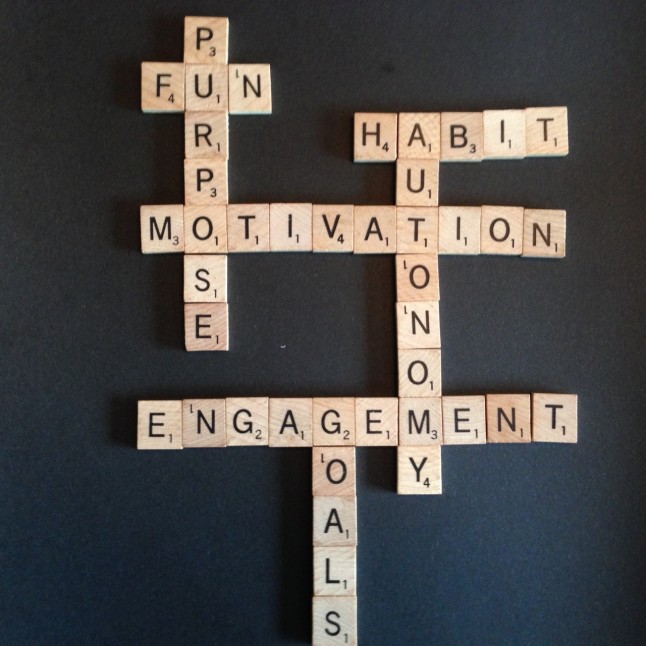How do you stay motivated to continue learning, doing assignments, and progressing as a lifelong learner?
“Humans, by their nature, seek purpose—to make a contribution and to be part of a cause greater and more enduring than themselves.” – Daniel Pink, Drive
Why is it then that many of us struggle to motivate ourselves? What is the secret behind motivation and learning? We cannot start to answer these questions without first defining motivation.
Wikipedia defines motivation as: “The driving force that causes the flux from desire to will in life.” Educational psychologists define motivation as, “…the processes that energize and give direction or purpose to behaviour (Wlodkowski, 1989).”
In simple terms, I think motivation is the internal desire to complete a task one has imagined possible. I clearly remember the night I decided to run my first ultramarathon. It was New Year 2006. I had been trail running for about a year, and could consistently run for a couple of hours on the trails without issue, but the Diez Vista was an altogether different challenge. I would be required to run non-stop for over seven hours. Where did the motivation come from to transition from running two hours on a Saturday morning with friends to running 50km? Looking back there were six key elements to my motivation:
- Plan/schedule – at the time I was running with friends who had developed a detailed training plan
- Practice – every time I practiced, I felt stronger and moved a little closer to the goal
- Confidence – after each training session I had inevitably run longer than I had ever done before, and with that my confidence and belief in myself increased.
- Overcoming adversity – on our last training run which was scheduled to last about 7 hours. I snapped the laces on my trail shoes and got lost. The smaller group I was with turned a 7 hour training run into an 8.5 hour run. At that point i knew I could finish the race.
- Support – I received and gave emotional support to ten friends for the four months we trained for the race. I also received coaching, tactical, and nutritional support from my fellow runners.
- Challenge – for the majority of the time I was training, I wasn’t entirely sure whether I could actually complete the race, and I believe this uncertainty was a driving force behind my motivation.
My mantra throughout my training was an inspiring quote I found in a running magazine in 2006:
“Your biggest challenge isn’t someone else; it’s the ache in your lungs, the burning in your legs, & the voice inside you that yells, “Can’t!” But you don’t listen, you push harder. You hear the voice whisper “Can.” and you discover that the person you thought you were is no match for the one you really are.” - unknown
Motivation and Life-Long In Education
When I think of my own motivation for lifelong learning it stems from a desire to master my craft. I can see the educator I want to be. I have a strong mental image of him. I know exactly what he looks like, his educational pedagogy, how he interacts with his learners and his peers, and how he designs his learning experiences.
A recent Scientific American article titled, Three Critical Elements Sustain Motivation helped me to better understand how I maintain a love of learning, and what keeps me motivated through the process.
Self-determination
Motivation can manifest speedily when we feel like we are the captains of our own ship. When we have a level of control over the direction of our learning, we are more likely to be motivated to move along the continuum to mastery. The energy and enthusiasm applied to a given task increases significantly when one is given the freedom to approach a new learning experience in ways that best suits one’s own learning style. Learner autonomy is important in this phase. As Dirksen says, “You may be able to influence your learners, but you can’t control them.”
Purpose
When I compare the most successful learning experiences I have had with my learners with my own learning experiences I noticed that both events have a clear purpose for learning. When I canvas my learners about learning that is most purposeful I often hear responses such as “Can I use it in real life?” and “Will this help me with…” In order to motive today’s learners the work they complete needs to have real life applications. It has to be authentic and engaging. More importantly, the work needs to be purposeful for the learner and not necessarily what the teacher thinks is purposeful. The only way an educator can achieve this is to spend the necessary time to understand each of his/her learner’s needs.
Progress
Proficiency is equally important in the science of motivation. To maintain motivation levels one needs to feel success on a regular basis. Going back to my trail running experience for a moment – If I hadn’t see small gains in performance each week, then I’m sure my motivation levels would have dropped to the point that I would have discontinued my goal. From a learner’s perspective I believe it is important for students to see and measure the progress they are making in order to maintain their motivation levels. Video gaming is an excellent example of facilitating an ongoing level of progress to maintain motivation. Gamers are constantly being provided with feedback on their performance. This feedback enables them to see progress, and they can visualize their goal and maintain their motivation.
References:
http://www.scientificamerican.com/article/three-critical-elements-sustain-motivation/
http://www.personal.psu.edu/bxb11/m&g.pdf
http://en.wikipedia.org/wiki/Motivation
Design For How People Learn, Julie Dirksen
